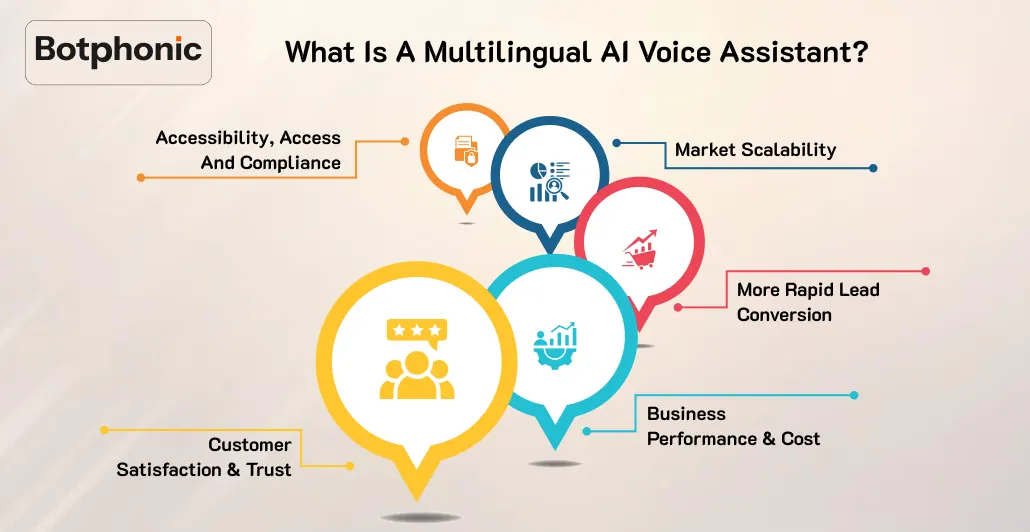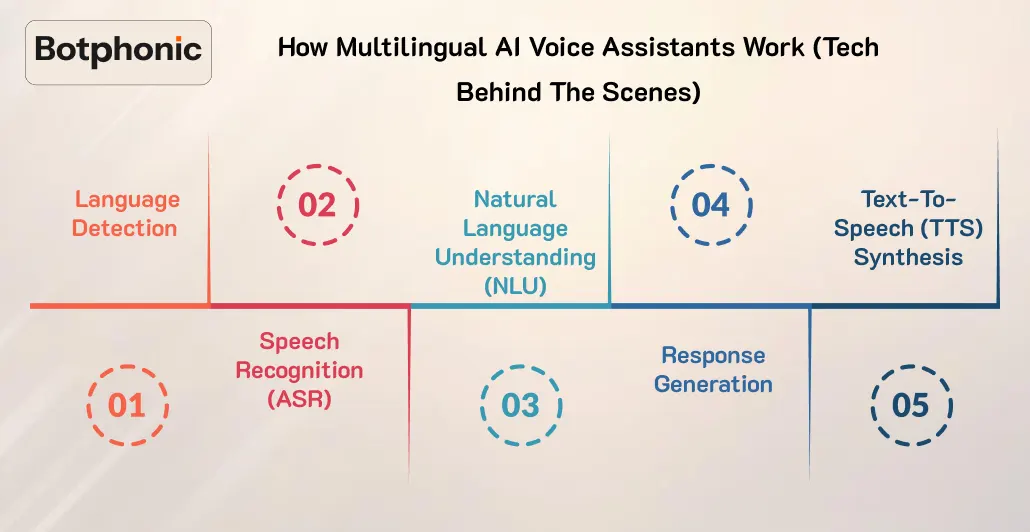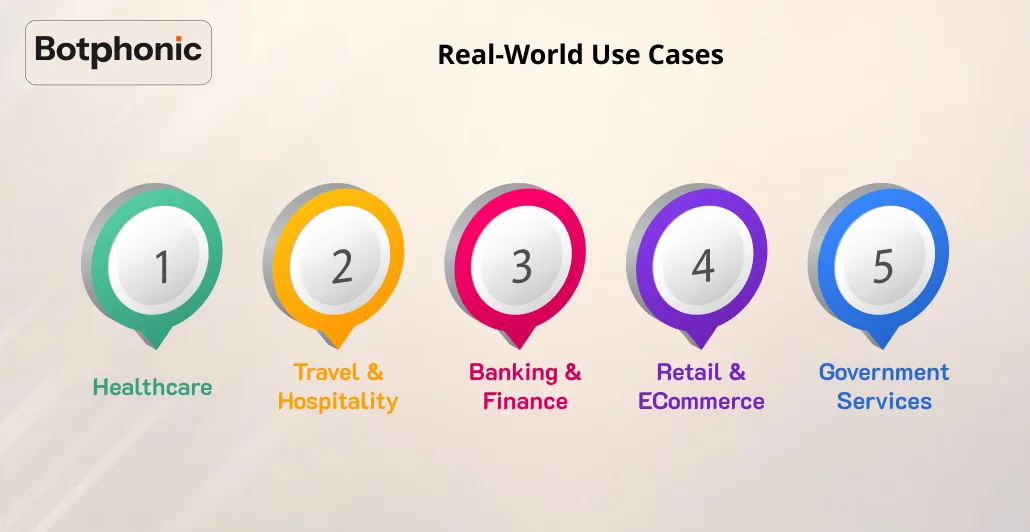
Summarize Content With:
Summary
This blog will discuss the importance of multilingual AI voice assistants in the US, what they do and how they will increase customer reach, efficiency and satisfaction. Naturally, we shall examine the numbers, the benefits and the practice examples as well.
Key Takeaways:
- A variety of AI voice assistants help you to communicate with customers in their native language and work on improving consumers’ trust and communication.
- They offer prompt and cheaper assistance with authentic 24/7 services in varied languages.
- Sentiment and tone analysis between languages is one of the ways that voice AI assistant systems can drive greater intelligence.
- Conversational AI voice assistant tools in the market today place brands in the leading position in a multicultural market.
Introduction
Consider the last time you dialed a customer support number. Most likely, you would be required to dial one for English, two for Spanish, and then wait in a long line to talk to a person who would have no full comprehension of your problem.
Just imagine a better world, namely one where you engage in utterances with your phone in your native tongue in a natural manner, and an AI voice will respond, i.e. sounding human and warm, with a sole comprehension of your words.
It is no longer science fiction. With the help of current developments in conversational AI and voice assistants, companies are now capable of having immediate interactions with consumers in more than 20, 50, or even 100+ languages.
Let’s explore the multilingual AI voice assistant.
The Growing Demand for Multilingual AI Voice Assistants
First of all, the numbers. The application of voice assistant AI in daily life is already extensive and is developing at an impressive speed.
A report by Statista indicates that digital voice assistants are used by over 4.2 billion people worldwide. By the end of 2024, it is on track to exceed 8.4 billion people, which would surpass the entire global population.
And in the U.S., already, 48.7 per cent of internet users are using AI voice assistants, either on phones, smart speakers, or in-car systems (Itransition).
And here is the point: the multilingual market is underserved. Although AI assistants, such as Siri or Alexa, support multiple languages, most business platforms remain exclusively English-based and, therefore, struggle to communicate effectively with various customers.
This is where a multilingual AI voice assistant comes into play.
What Is a Multilingual AI Voice Assistant?

A multilingual AI voice assistant is an intelligent machine that can listen, translate, and speak in different languages in real-time voice communication.
In contrast to typical voice bots or IVR systems, AI-driven voice assistants can conduct dynamic conversations with a human-like nature through natural language processing (NLP) and machine learning algorithms.
They are not just people who read the scripts:
- They can identify languages and accents.
- They adjust the tone depending on the cues to emotion.
- They simply answer calls, make follow-up calls, and transfer calls to a caller in their native language.
Whether in Spanish, Hindi, Arabic, or French, a conversational AI voice assistant would conduct the conversation without a hitch. In most cases, it would speak with almost human-like intonation and empathy.
Benefits of Multilingual AI Voice Assistants
| Feature | Benefit |
| Multilingual Understanding | Connect with users in their native language |
| Real-Time Lead Qualification | Instantly qualify and route high-quality leads |
| CRM & Tool Integration | Syncs with Salesforce, HubSpot, and more for a smooth workflow |
| 24/7 Voice Availability | Engage customers any time—even after hours |
| Accent & Dialect Adaptability | Understands regional speech variations and tones |
| Cost-Effective Scalability | Serve more customers without increasing human support teams |
| Personalised Voice Responses | Tailor’s tone, style, and answers based on language and culture |
| Compliance Support (e.g. GDPR) | Ensures legal and ethical multilingual communication |
1. Customer Satisfaction & Trust
Greetings in the native language make people feel that they are being treated as individuals. AI voice assistants are multilingual, which creates a seamless and inclusive experience for customers. They eliminate irritation and misunderstandings, which in turn fosters long-term loyalty.
2. Business Performance & Cost
It is expensive to employ multilingual employees to provide support 24/7 in different time zones. AI virtual assistants do not require sleep and can attend to hundreds of calls simultaneously. Using a single system, you can provide every kind of service in a variety of languages without paying a huge payroll.
3. More Rapid Lead Conversion
AI voice assistants are not just those that answer questions. Those trained can qualify leads, make appointments, and respond to pricing or product questions, and do so in real-time, as well as in the customer’s preferred language.
Let an AI voice assistant do the talking automatically, politely, and fluently.
Start using multilingual AI voice calls today4. Market Scalability
Thinking about launching into a new area or target? AI virtual assistants (of different languages) facilitate the delivery of local support effortlessly, without recruiting region-based teams. This implies that you can transition from a regional to a global perspective.
5. Accessibility, Access and Compliance
In 2017 the need for accessibility is not a pleasant-to-have but a matter of legality and ethics. With the assistance of the voice assistant AI, low-literacy users, those with visual impairments (including limited eyesight), and physically impaired users can engage in meaningful conversations by speaking only.
Best AI voice assistant will guarantee a speedy and polite service to all users, no matter their abilities, which will also assist your company to reach such compliance standards as ADA and GDPR.
How Multilingual AI Voice Assistants Work (Tech Behind the Scenes)

Learning about the functionality of this technology will help you make more informed adoption decisions. So this is the way everything is put together:
Step 1: Language detection
In the first few seconds, the assistant locates the language being communicated. It will not require a menu or manual choice.
Step 2: Speech Recognition (ASR)
In the spoken input, Automatic Speech Recognition (ASR) is optimised for regional accents.
Step 3: Natural Language Understanding (NLU)
The assistant can use AI models to determine the meaning of words, not just the words themselves, but also their intent, context, and emotion.
Step:4 Response generation
It creates a human-like reply, either using a pre-prepared script or dynamically, and translates it where necessary.
Step 5: Text-To-Speech (TTS) synthesis
The reaction is expressed in a natural voice with proper pronunciation, rhythm, and emotional intonation.
Real-World Use Cases

1. Healthcare
Hospitals now use AI call assistant in providing appointments in either Spanish, Arabic, or Chinese. Naturally, patients engage with each other without translators.
2. Travel & Hospitality
Hotels offer check-in and check-out services in various languages through AI assistant devices. Visitors do not even feel like strangers in a strange land, and employees are relieve.
3. Banking & Finance
Customers receive assistance with account details, credit forms or fraud notifications – immediately and in their language.
4. Retail & eCommerce
Through voice assistants, one can place orders, request returns, or track their deliveries in several languages.
5. Government Services
Hyperning multilingual bots are used in city hotlines and DMVs to process frequently asked questions and save manual workloads.
Use voice assistant AI to greet, guide, and qualify leads in 20+ languages automatically.
Launch your multilingual voice agent todayTips for Successful Implementation
- Consider the 35 major languages used by your customers.
- Train your assistant using actual conversation data (and not textbook translations)
- Keep track of the analytics on monitor calls on the language level and their consecutive enhancement
- Voice tests on native speakers, accuracy and clarity of accent Check
- Be GDPR, HIPAA and privacy law compliant.
Final Thoughts
Multilingual voice assistants within AI are no longer a choice in the United States, as the country is culturally different and linguistically diverse. They enable businesses to shatter language barriers and provide bilingual on-demand support immediately.
When you integrate AI voice assistants into customer service and lead generation workflows, not only do you enhance customer satisfaction, but you also become more efficient. Using voice assistant tools that AI enables, you can reach customers all around the world, which will help you lower expenses and appeal to customers as humans. Accepting this change implies that your business will be more open to access and participation, as well as ready to embrace the future.

